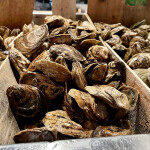Representatives from the countries in the Northern Committee of the Western and Central Pacific Fisheries Commission met on Monday to start a five-day conference where the main topic will be the Pacific bluefin tuna.
The tuna, which is considered a prized delicacy, has reached population levels that are alarming some activists, who blame overfishing, especially of young fish in the species. Organizations such as The Pew Trust have called on a fishing moratorium if the countries cannot devise a plan that would rebuild the population. In addition, a group of nearly 200 chefs and other culinary leaders have joined a boycott and have refused to sell the fish until a sustainable management plan is in effect.
Margaret Spring, the chief conservation officer at the Monterey Bay Aquarium, said one of the main reasons the Pacific bluefin tuna is reaching such low numbers is that many of the fish aren’t being allowed to reproduce.
“About 80 percent of what they’re catching is age zero,” Spring said. “They never get to spawning.”
The commission has announced its initial goal for the species is to install measures that would increase its population by 2024 to about 41,000 tons, a figure that represents the median population of the species from 1952 to 2014. By 2030, the commission wants the tuna’s numbers to reach 20 percent of its historic population. Officials want to take steps that will create a 60 percent chance of attainment for both goals.
By comparison, activists estimate the current population is at less than three percent of its historic population, or 17,000 tons.
The question now is whether committee members can reach consensus this week during its 13th Regular Session, being held in Busan, South Korea, on how to achieve those targets.
The United States, a commission member, has submitted a proposal designed to help the group reach its targets and establish conservation measures anytime the Pacific bluefin tuna population dips below 15 percent of its historic population.
Another country being watched closely this week is Japan, which announced earlier this year that it exceeded its catch limits for the year. The country is the world’s leading harvester and consumer of the tuna, which is sold in sushi restaurants. Earlier this month, Japan announced a quota reduction in 25 of its prefectures. In addition, Japanese Fisheries Agency officials added they plan to subtract any overages from the ensuing year’s quota.
However, in its proposal to the commission, Japanese officials offer a sliding scale quota system. That would reduce the quota for smaller fish if sustainability projections dip below 60 percent certainty. However, those quotas would rise if projections rise to 65 percent.
Spring, who was involved in similar negotiations over limits with Atlantic bluefin tuna, said Japan faces a challenge because it has raised concerns about the overfishing of other species.
“Japan was very active in pushing the E.U. to reduce their catch, and they did it too,” she said. “These are decisions that are made. All these countries meet all the time about fisheries. I wouldn’t call it quid pro quo, but I would say you can’t demand one thing in one corner of the world, then not deliver it in another.”






